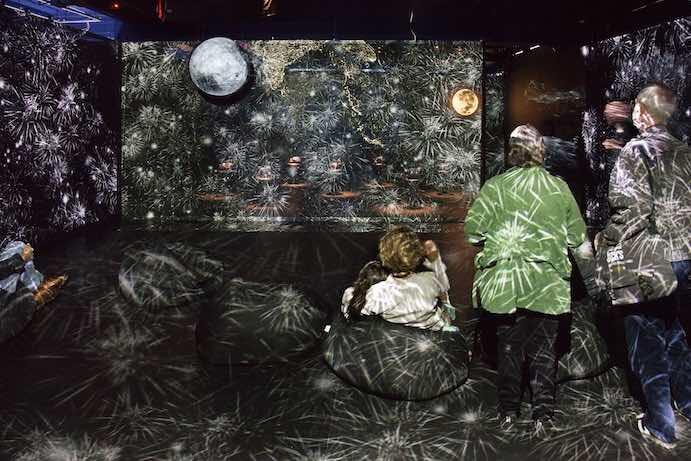With my head tilted back, I gazed up at the stars. Against the black of space, the constellation read ‘Democracy,’ and then burst into dust. I looked down at my hands, which had transformed into gloves of an astronaut’s spacesuit. And there I was, standing on the moon.
I’m not one to dream vividly; my dreams often seem erratic, fleeting, and nonsensical. The wondrous imagination and agency of lucid dreaming is a frightening enigma: to consciously explore an abstract world of your design. While not a dream, Laurie Anderson’s virtual reality (VR) installation To the Moon, is perhaps a glimpse of that nocturnal lucidity, and an invitation to let oneself be drawn into an abstract lunar-scape and find a childlike-curiosity.
To the Moon is the third VR collaboration between Anderson and artist Hsin-Chien Huang, commissioned by the Louisiana Museum of Modern Art, Denmark, on the 50th anniversary of the lunar exploration. The immersive audio-visual experience held its UK premiere this July as part of Anderson’s new residency with the Manchester International Festival. As former Artist-in-Residence at NASA–resulting in a subsequent work, End of the Moon–Anderson has held a long fascination with the expansive solitude of space and human experience.

As an artist, in the truest and most inclusive sense, Anderson’s creative output as a filmmaker, author, composer, visual artist, and performance artist is now an oeuvre entwined with forty-years of personal, social, and political history. The creative constellations of Anderson’s conceptual mind float above the limits of real-world materiality; in many of her multimedia works, the creative use of new technologies have allowed the realisation of that imagination, connecting sight to text to sound.
While To the Moon is primarily an exploratory visual experience, the composition of sound relocates the viewer within Anderson’s abstract world. Prior to entering the VR-experience, the viewer is first introduced to Anderson’s sonic material in a dark room of visual projections and omnidirectional sound. On the wall, a space-rock-textured rose spun in motion, while DNA-code of star-like constellations washed across the floor; stars exploded like fireworks, and space junk drifted in orbit. The sound enveloped as electromagnetic static flickered, crickets chirped, a Mongolian throat singer droned, and a blacksmith sharpened her blade.
As in To the Moon, Anderson’s renowned storytelling runs through many of her compositions, notably in her album Homeland (2010), and Grammy award-winning Landfall (2018). The composer’s textural writing is quite sculptural in its sense of space and temporality. Floating over a delicate electronic hum, the violin rises and falls in arching lines, expanding outward with the grandeur of otherworldly reverberance. Her narration flows in dialogue with violin, building emotive intensity. Listening to her voice, her words are gently placed, one after the other; the tone is rounded, soft, and heavy.

“You know the reason I really love the stars? It’s that we cannot hurt them….but we are reaching for them. We are reaching for them,” Anderson narrates.
Anderson’s sonic environment in To the Moon dislocates the viewer from a world of spatial locality and coherence, and thrusts them into a fictionalised lunar-scape where the mind is free to fly. Of the world’s political and environmental crisis, Anderson is certainly aware. The competing national flags on the moon’s surface and mountains of anthropocene waste-dump suggest a bleakness; yet as an artist, Anderson offers a different answer: to allow us to, for a moment, let it go, and fly.
Stretching out my arms, I took flight through the transparent belly of a three-dimensional sperm whale, rested on petals of a planet-size rose, and rode a donkey in a meteor shower. For that moment, I forgot I was sitting on a swivel chair, attached to a suspended headset, and holding a trigger controller in each hand. I forgot that very bizarre circumstance, and left our very strange world for another.
























